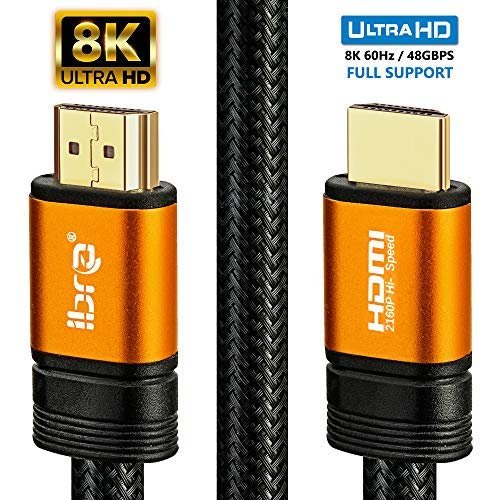Things you should know about high-speed HDMI Cable
Understanding cable standards and capabilities are vital when choosing computer cable kinds. For instance, the HDMI version and signal transfer rate of high-speed HDMI Cable are used to categorize them (bandwidth). These are the various HDMI cable kinds.
Typical HDMI Cable
The most fundamental HDMI cable, Standard, was created for older consumer applications. The cable’s 5Gbps bandwidth offers resolutions of 1080i or 720p. 4K and higher resolutions cannot be transmitted using standard HDMI cords.
The 30Hz refresh rate of the Standard HDMI connection makes it a good option for screen projectors, DVD players, and satellite TVs. This cable supports HDMI versions 1.0 to 1.2a out of the box.
Commonplace with Ethernet
The performance capability of this cable is equivalent to that of ordinary HDMI cables. The primary distinction is that it has a separate data channel. An Ethernet Channel must be configured on both connected devices to use the feature.
Typical Automotive
In-car HD video systems are built for Standard Automotive. The connection is frequently used to connect portable or in-car DVD players to in-car video screens and offers the same characteristics as a standard HDMI cable. Additionally, it can tolerate vibrations and convey powerful impulses.
HDMI High-Speed Cable
Signals in 1080p, 4K at 30Hz, and 3D can all be transmitted using a High-Speed HDMI cable. Its 10.2Gbps bandwidth makes it ideal for HDMI versions 1.3 through 1.4a.
The High-Speed HDMI cable is suggested for Blu-ray players and video consoles that can support 4K resolution and also supports 3D and Deep Color technologies.
Ethernet-enabled high speed
Including a high-speed connection, a High-Speed HDMI cable with Ethernet provides characteristics like support for 1080p up to 4K and cutting-edge display technology. The primary distinction is that they have an exclusive data channel called the high-speed HDMI Cable and Ethernet Channel.
This kind of cable is an excellent option for systems that enable Ethernet streaming channels, even though very few devices are compatible.
Fast-Moving Automotive
The only difference between a high-speed automotive HDMI cable and a standard high-speed one is that the former was created expressly for usage in the automobile sector. Automobiles operating at high speeds can withstand the particular strains of the automobile environment, such as temperature extremes and vibrations.
Exceptional High-Speed
Exceptional High-Speed In addition to being designed for HDMI versions 2.0, 2.0a, and 2.0b, HDMI supports a bandwidth of up to 18Gbps. The cable supports BT:2020, 4K at 60Hz, HDR, 4:4:4 chroma sampling, and broader color schemes.
The cables are available for HDMI Type A and Type D connectors and feature minimal electromagnetic interference (EMI). The best option for PC gaming and design software is Premium High-Speed.
Look for a cable that has a Premium HDMI Cable Certification Label to be sure it complies with the requirements for this category. Each certified product label has a distinct holographic fingerprint and a QR code that you can scan with the HDMI smartphone app to verify the device’s certification.
HDMI Ultra High-Speed Cable
The Ultra High-Speed HDMI cable supports uncompressed 4K at 120Hz and 8K at 60Hz up to a 48Gbps bandwidth. On an HDR TV, the cable can provide videos up to 240Hz and a resolution of up to 10K.
Since Ultra High-Speed HDMI is backward compatible with earlier HDMI standards, it supports HDMI 2.1a and is, therefore, compatible with practically all HDMI devices. Additionally, it is less vulnerable to the EMI that some wireless gadgets create.
Additionally, it supports recent features like VRR and eARC (Enhanced Audio Return Channel) (Variable Refresh Rate). Look for the Ultra High-Speed HDMI Certification Label on the cable package to ensure compliance with all requirements.
Types of HDMI Connectors
An end-connector is necessary for an HDMI cable to fit into a specific display device and source. There are numerous HDMI connector types, but only four are genuinely important. These HDMI connector varieties are listed.
USB Type A (Standard HDMI)
Standard source devices, laptops, game consoles, and Blu-ray players to TVs and projectors commonly employ standard HDMI connectors. The most significant HDMI connector is Type A, which has a 19-pin setup.
USB Type B (Dual-Link)
Although it was created for highly high-resolution displays, this HDMI connector is not now seen in any popular consumer goods. This is because, with the introduction of HDMI 1.3, a single connection’s speed surpassed that of the previous dual link.
USB Type C (Mini HDMI)
Mini HDMI connectors have the same full capabilities as conventional ones and have a 19-pin layout. Type C, however, is more petite and trim than Types A and B. It’s probably present on more compact, portable gadgets like tablets, DSLR cameras, and even a few computers.
Lastly,
Although Micro HDMI is more minor than Mini HDMI, it still has a 19-pin layout and has all of the same features as its bigger siblings. Mobile gadgets like cellphones, tiny cameras, and other portable electronics typically use this connector type.
